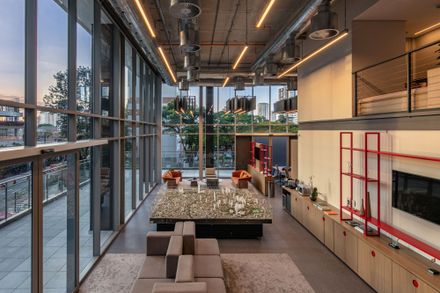
Crona 665 Building
ARCHITECTS
Andrade Morettin Arquitetos
FRAMES
P. Martins Engenharia
MASONRY
Addor & Associados
CO AUTHORS
Vinicius Andrade, Marcelo Morettin, Marcelo Maia Rosa, Renata Andrulis
COORDINATOR
Guilherme Torres Martins
LANDSCAPE DESIGN
Benedito Abbud Arquitetura Paisagística
COLLABORATORS
Daniel Zahoul, Izabel Sigaud, Murilo Zidan, Fernanda Mangini, Raphael Souza, Guilherme Torres Martins, Ana Paula Silveira, Arthur Frensch, Maria Carolina Bomeny
CONCRETE STRUCTURES
França E Associados Projetos Estruturais
FOUNDATIONS
França E Associados Projetos Estruturais
CLIMATE INSTALLATIONS
Thermoplan Engenharia Térmica
ACOUSTICS
Akkerman Alcoragi Acústica Ideal
AUTOMATION
Si2 Soluções Inteligentes Integradas
METALLIC STRUCTURES
Steel Make Engenharia Estrutural
WATER PROOFING
Proassp Assessoria E Projetos
PROJECT MANAGEMENT
Favo Arquitetura
YEAR
2022
LOCATION
Tatuapé, Brazil
CATEGORY
Apartments
Text description provided by architect.
Designed as an integral part of the so-called “Platina Axis,” the project aims to offer high-quality spaces for work, services, and leisure to the neighborhood and the East Zone as a whole, contributing to the reduction of long and exhausting commutes to historically centralized work hubs in the city.
The Crona 665 building occupies a prime location at one of the main intersections of the Platina Axis, between Platina and Vilela Streets.
Its neighbors include developments offering a wide range of services such as retail, dining, healthcare, leisure, and residences of various sizes.
Located just 150 meters from Carrão Metro Station, with proximity to major access roads, train stations, bus corridors, and bike lanes, Crona 665 establishes direct connections between businesses and people.
As an essential component of a business ecosystem aimed at socio-economic development in Tatuapé, Crona 665 stands out not only as an ideal space for large companies but also contributes to the enhancement of the urban environment.
Its recessed positioning allows for maximum sidewalk width, providing pedestrians with favorable circulation conditions.
With landscaped and shaded areas, adequate lighting, and interesting urban furniture, the building creates a pleasant and safe transition between public and private spaces, fostering interpersonal interactions in the area.
The tower's design adopts the premise of "open space" corporate floors, with large and continuous areas, adaptable to various occupancy schemes.
To this end, technical and service areas are rationally grouped around the tower’s circulation core, consolidating it as the building's core.
The advantage is that the building's perimeter is entirely available for work zones, in direct contact with natural light and surrounding views.
In the transition from the tower to the base, a more open and generous corporate space is conceived, with double-height areas and extensive balcony sections.
At the street level, most of the frontage is occupied by stores, all recessed to provide the maximum possible floor area for pedestrian circulation and use.




































